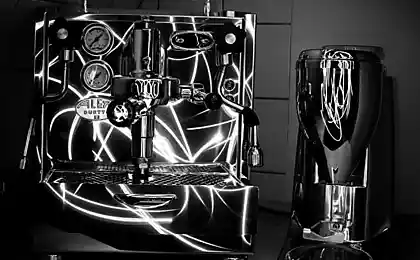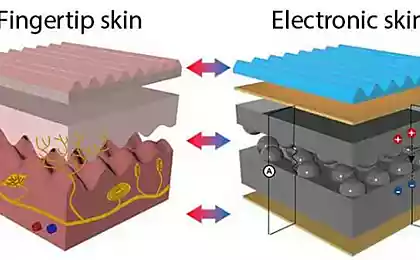635
Electronic skin that reacts to pressure, sound and temperature detect surface texture

Welcome to the pages of iCover blog! His vision should look like the future of electronic skin suggested the group of Professor Hong San Li from the Institute of Dong-A University Busan in South Korea. E-skin or electronic skin - just one of the varieties of artificial leather, which has the potential to be used as human and robot. How promising is seen a variant proposed by Professor Hon and what fundamental differences between its proposed version of the artificial skin of the electric alternative solutions proposed in the past?
One of the main areas in which today is engaged in the laboratory of Professor Hong San Li - polymer nanomaterials. Nanocomposites prepared in its walls - a transparent conductive film, ferroelectric (ferroelectric) film, gastight film already in the near future may be used in various fields, particularly as part of the structure of an organic LED display or mobile phone display, prosthetics and robotics .
Leatherette Professor Hong
Unlike alternative, existing artificial leather variants, E-skin, scientists proposed Korean group made of a ferroelectric material that generates electricity in response to external stimuli, such as pressure, temperature, sound. In the end product, structure - the thin film, the sensory temperature and pressure were used developed by scientists ferroelectric nanocomposites of polyvinylidene fluoride (PVDF / PVDF) and reduced graphene oxide preserving ferroelectric properties even after processing cycle (formation of an alloy or solution casting) without the need for additional "teasing".
The ability to "feel" the pressure and temperature of this composite film becomes just because ferroelectricity. Two layers of a micro-embossing the film after it possible to obtain a relief structure with significantly improved characteristics of sensitivity to external influence. The ribbed surface, like a picture on our palm or fingers informs skin versatility, which manifests itself in the ability to feel like the dynamic and static pressure and temperature influence. Sensitivity created by a group of Korean scientists artificial electronic skin, according to Professor Hong, is so great that it is possible to experience even one lying on her hair and ambient sounds. As
generated ferroelektrichestvo
The electric charge in the ferroelectric nanocomposite can be accumulated in the polar phase by mechanical action. The polar phase in nanocomposites based on the reduced graphene oxide and polyvinylidene fluoride was proposed to form by incorporation into the structure of PVDF. The magnitude of the generated voltage is generated proportional to the ratio of the charge to the electric capacity.
Simulated fingerprint, scientists have linked together epidermal and dermal structures of human skin. In this case the inner dermal layer included the mechanical receptors, recording steady pressure, the rest - the locking pressure changes and vibrations. Thanks to micro-embossing relief two-layer ferroelectric film becomes sensitive to sound and texture. Resistance e skin varies with the contact area between the outer and the inner layer due to changes in the supplied static or dynamic pressure.
The ability to respond to temperature changes is generated due to the mechanisms similar to those which stimulate the accumulation of electric charge in the polar phase. Thermodynamic composites changes result in a change of the contact resistance between layers of the reduced graphene oxide (rGO), which makes it possible to experience temperature changes.
"Thus, our electronic skin - says Professor Hong is a multi-functional, such as the tip of a human finger, feeling static and dynamic pressure, temperature, and texture at the same time."
Developments in this direction are not the first year and some results have already been achieved. But it is in versatility and is the fundamental difference between the electronic artificial skin, created by Korean scientists from the options proposed by the scientific community to this point and provide sensitivity at the level of one or at most two key features: dynamic pressure, static pressure and temperature. Development Hon laboratory allows to provide not only all three sensitivity parameter characteristic of human skin, but also the ability to react to fluctuations of sound waves and detect features of surface texture.
As electronic skin "feels"
sounds Everything is quite simple. Sound - no more than the air pressure changing in time. Sensitive electronic skin e-skin, which is much more sensitive than a conventional microphone is enough to feel the change of oscillation frequency response to identify patterns and generate corresponding currents.
Nanocomposites are created in the laboratory of Professor Khona have reduced electrical resistance due to the distribution of the reduced graphene oxide in PVDF and can be used piezoresistive (piezoelectric semiconductor) sensors and a ferroelectric sensors. Material thermoplastic turned. Using molding technology from a melt or casting of the film of the solution can be forced to accept and repeat any shape (for example, mikromodelnye structures) without compromising the ferroelectric and piezoresistive properties.
Thus, it becomes possible to create microstructures adhered to the ferroelectric film, allowing to strengthen the piezoresistive, piezoelectric and pyroelectric sensitivity to dynamic and static thermomechanical signals. In alternative experiments in which to create artificial skin, the researchers used passive graphene foam, field effect transistors, polarized ceramic polymers samples of artificial skin was obtained having sensitivity to temperature and pressure - said Professor Hong, but it may not be out of the question, to reproduce the micro-relief while preserving the ferroelectric properties.
Very promising for the application of e-skin with similar properties such areas as anthropomorphic robotics, prosthetics, creating mobile devices with human health monitoring, the Internet of Things and others. Thus, depending on the application, it will be possible to shift the focus on the desired properties of predominance. For example, E-skin, used in robotics will have to have a high resistance to significant pressure differences without loss of sensitivity, and being used for prosthetics - have an additional interface to broadcast signals to the brain.
Dear readers, we are always happy to meet and wait for you on the pages of our blog. We will continue to share with you current news, review materials and other publications, and will do everything possible to ensure that the time spent with us was helpful to you. And, of course, do not forget to subscribe to our column.
Our other articles and events
- Gator Caref Watch. Taking care of your child
- Spring discounts from KitchenAid
- Sale
- Sport vs fitness: Fitbit Charge HR and Polar M400
- The choice of smart watches Today. What has changed
- The future of SSD drives to M.2 -? Review Sandisk x300s
- Xiaomi Power Bank 16000 or Xiaomi Power Bank 5000? Browse new products
Source: geektimes.ru/company/icover/blog/272318/
Artificial fingers learn to recognize the surface roughness
Watch the movie in the first VR-cinema is 12.50 euros























